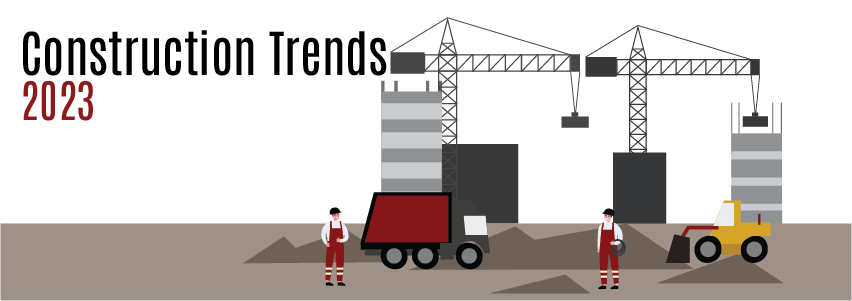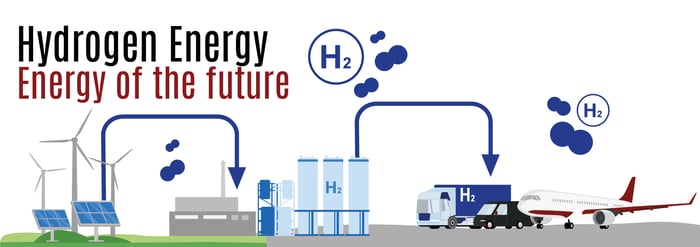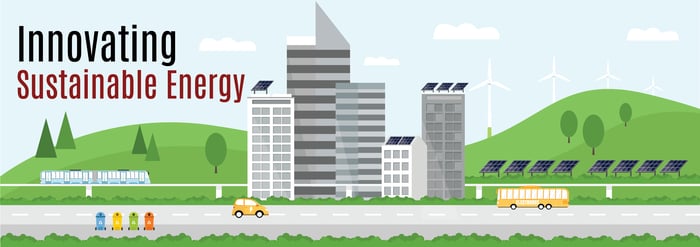Construction Trends 2023
Tips & Tricks • 3 min read • Sep 7, 2023 10:17:57 AM • Written by: Natasha Osborne

The construction industry, just like most other industries is adapting and considering making necessary changes to keep up with current trends as and when they emerge. Advancements in technology are gradually influencing the methods in which day to day operations run.
One of the key trends in 2023 has been a shift to modern methods of construction and moving away from traditional on-site skilled labour to the automated, off-site modular builds. As the industry is currently dealing with a shortage of labour, and there is a growing desire for more viable options. To not fall behind, you must keep up and with plenty of benefits in doing so, it’s clear to see why. So, let’s explore further and uncover the construction trends for 2023.
Increase of Renewable Energy
Increasing the use of renewable energy ensures new buildings run more efficiently and reduce their carbon emissions. Solar Panels are the most popular methods of renewable energy, using sunlight to generate energy. Considering the design of the building is also beneficial when aiming to reduce energy. Windows that are designed to make the most use of the sunlight can help to reduce the need for indoor lighting, therefore reducing emissions. Other options also include air source heat pumps, to cut carbon emissions down for a smaller carbon footprint. There are more eco-friendly options when it comes to materials and heating systems, including wind energy that reduces emissions. Passive cooling systems provide great ventilation and offer a balance for health benefits to people and enhances the efficiency of the building.
Technology and Innovation
Technological advancement within the construction industry allows processes to be enhanced and more efficient. With updated devices, machines, and sensors improving performance on site. This also makes it safer for workers, by using intelligent decision-making processes it reduces the risk of human error. There is an expectation for an increase in the adoptions of IOT devices (Internet of things) in construction to continue in the coming years.
Robotics and Automation
The use of robots and automation has proven to improve efficiency, accuracy, and safety. The use of drones, 3D printing, and autonomous vehicles can reduce construction costs, speed up processes and reduce errors. Drones have been used in the industry for over a decade to enhance the production process. As technology has improved, more sophisticated AI-orientated drones with real time aerial imagery and 3D lidar scans are revolutionising systems.
Prefabrication and Modular Construction
As construction methods adapt and shift towards more modern concepts, less components will be assembled on-site, and we will start to see more off-site construction. This allows factors such as weather and shortage of skilled labourers to not cause delays and reduce efficiency. There is anticipation that this will continue to become more popular as it reduces costs and ensures the process runs smoothly.
Augmented Reality and Virtual Reality
Augmented and virtual reality is also shaking up the construction industry, these immersive experiences present the opportunity to enhance production. It allows architects to visualise their drawings in a real-life simulation. This process significantly reduces costs and can be used throughout the entire project to oversee the design, catching any errors early in the process, saving time. An example of this is Mott MacDonald, a company that applied 4D simulation to its Haweswater Aqueduct's Bentley pipeline project, that resulted in saving the company 20 days.
It will be interesting to see how these current trends will continue to enhance the construction industry and what advancements we can expect in the future. The pandemic and the introduction of hybrid working has also had an impact on the construction industry, highlighting the industries vulnerability. A report from McKinsey states that ‘demand for office and retail space will remain below pre pandemic levels.’ As a result, many empty office spaces remain post pandemic, with low demand low there is no urgency for new buildings to be built. The number of people living in cities also reduced, so perhaps there will be an opportunity to branch the concept of ‘developing mixed-use neighbourhoods’ to make use of vacant office spaces. To create new office and retail space, which will also present more jobs for labourers.
Overall, it’s clear to see the construction industry is moving towards a more sustainable future, with growing pressure on developers to meet demands of more environmentally conscious customers, choosing more ethical options and using eco-friendly materials is more ideal. Locally sourced products and a design for a sustainable, green- building, will be key to the success and likely the focus for the next decade.
We hope you enjoyed this week’s blog and learned something new about the construction industry. Why not leave a comment below to let us know your thoughts and suggest any topics you may like to read in the future. Feel free to share with others who may also enjoy reading the blog.
Reach the World. Giving Made Easy with Impact.
Related Articles

Tips & Tricks
Hydrogen Energy- Energy Of The Future?

Tips & Tricks
Innovating Sustainable Energy

Tips & Tricks
Procurement Trends 2023
Don't Miss Out On A Thing
Sign up and Join Our Newsletter Today